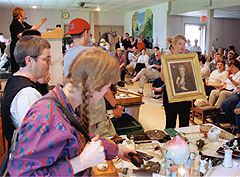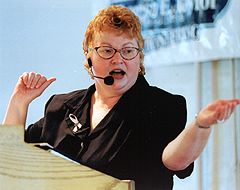|
Articles
PURSUITS/OUTINGS - Action at the country auction
By Cheryl Cornacchia - THE MONTREAL GAZETTE
Saturday, June 16, 2001
"Great finds are worth the trip, but steer clear of the collectors."
"Montreal's Notre Dame St. is the first place out-of- towners go to look for antiques. But there are dozens of lesser-known venues in and around the Montreal area to search for your favorite antiques and collectibles. This week, we check out a country auction."
"Country auctions usually charge less for collectibles than antique shop and sell off everything from vintage furniture to battered magazines"
 Outside a community centre in the eastern Ontario village of Martintown, Tim and Jocelyne Gadbois struggled with the result of an antique auction at which they just spent $833.75. Outside a community centre in the eastern Ontario village of Martintown, Tim and Jocelyne Gadbois struggled with the result of an antique auction at which they just spent $833.75.
The Cornwall couple are regular auction-goers, so they were not fazed by the price they paid for an Eastlake parlour table, a Gone With the Wind oil lamp electrified in the 1930s and two Victorian prints in their original gilded frames.
But the Cornwall couple didn't know how they would get their purchases home in their two-door, midsize family car.
"There," Tim Gadbois said, after a fifth try. He stepped back to survey the table finally resting on the front-passenger and rear seats of the car.
"There's just no room for my wife," he said as Jocelyne crammed herself in beside their latest acquisition.
Auctions are a lot of fun, and it's easy to get caught up in the excitement and the carnival-like atmosphere.
The country auction is a great place to find antiques and collectibles of all kinds. And for the most part, the prices are lower than what you would pay for the same items in an antique shop.
The Gadbois's ornately carved parlor table, for example, cost them $175, half of the price of a similar one they bought just a year ago at an antique shop in Cornwall.
Although antique auctions often attract collectors, who can drive the bidding up, attendees are just as often bidding against antique dealers who want to keep prices down.
At this auction, a 20-piece set of Royal Albert Vald'Or china went for $400, the bidding on a Hochriem Lollipop novelty scale stopped at $220, a Hoosier kitchen cabinet went for $875 and a Toby jug went cheap at $45, as did a paper-mache Easter egg from the 1890s.
Some of the box lots - boxes filled with odds and ends like pieces of linen, mismatched cups and saucers and old magazines - went for $2.50.
 At any auction, it all depends who is in attendance. As Theresa Taylor, the Cornwall Auctioneer officiating at this one, warned before it all began: "Those who know, know. All others bid accordingly."
At any auction, it all depends who is in attendance. As Theresa Taylor, the Cornwall Auctioneer officiating at this one, warned before it all began: "Those who know, know. All others bid accordingly."
At the Cornwall auction late last month, there were more than 200 registered bidders and almost 500 items, mostly antiques, belonging to 23 different consignors. Duncan Phyfe drop-leaf tables, wool winders, cedar chests, Indian artifacts, a Patsy doll in its original box, an 1876 needlepoint sampler, and toys, coins and jewelry were among the antiques and collectibles that animated the crowd, which started gathering 90 minutes before the auction began.
If you're new at the game, it's best to arrive early and look at everything during the designated preview time. If you decide in advance what your highest bid will be, you're less likely to get carried away once the action starts.
At this auction, bidding took off on several items, including a numbered Matisse etching ($750) and a rare Carnival glass epergne missing one of its flutes ($600).
"I've only seen one of these in books," said the Vankleek Hill antique dealer who bought the Carnival glass centrepiece despite its missing part. "I just love it."
In addition to watching the merchandise, it's good to keep your eye on the crowd. There are five basic types of buyers and the sooner you can spot who is who, the better your chance of getting a deal.
For example, the "collector" might not be the one you want to go up against. They carry catalogues and other reference books, and know heir stuff. If a piece that is about to be auctioned completes their particular collection, steer clear.
"Dealers" - the guys and gals who seem to bid on everything and bring their own boxes and packing materials - are more likely than collectors to stop when the bidding gets frenzied.
But it is the "pickers" - the people who buy and then sell to antique dealers - you want to go up against. They have to get great deals in order to stay in business.
As for the "consumer" - the average person who goes to an auction to get out of the city or to find something a little different to decorate their home with - it's hard to know what they'll do.
For the most part, however, the consumers are a little less likely to throw their money around. That kind of thing you tend to see from what auctioneer Taylor call "the yuppie who just likes it."
"You'll see them bidding and the rest of the crowd shaking their heads in disbelief," Taylor said.
"But, of course, they're not bidding alone. There's someone else. It takes two."
At Martintown, all five types of buyers were out in force. Among the auction's consignors were two collectors; one was downsizing his collection of antique toys and another was parting entirely with his collection of Indian artifacts, including a quill box, a doe-skin vest and a stretched beaver pelt.
"You can be in this atmosphere or you can be home alone checking out eBay on your computer," said Lee Cassidy, one of the auctioneer's assistants. "I tell people, "Come, the entertainment is free.' "
Just then Bob Johnston of Pointe Claire walked by wearing a yoke across the back of his neck that he had just bought for $25.
"When I saw it, I couldn't pass it up," Johnston said.
"It reminded me of growing up on the farm. I'm going to use it to carry water from the lake at my cottage to water my flowers."
Need we say more?
|

